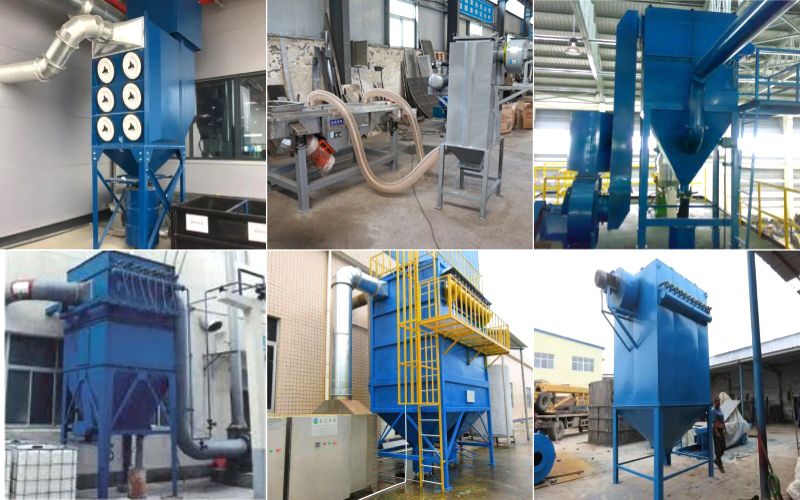Dust collector machines are designed to improve air quality in industrial and commercial environments by filtering dust, particulate matter, and pollutants from the air. These systems are commonly found in woodworking, metalworking, pharmaceutical, cement, and textile industries—anywhere that dust is generated as a by-product.
They function by capturing dust-laden air through a filter system, often using a fan or blower, and releasing clean air back into the workspace. Dust collectors help maintain a safe, breathable environment for workers and comply with air quality regulations.

Why Dust Collector Machines Matter Today
Dust collector machines have become essential for modern industries for several reasons:
-
Worker Health: Exposure to airborne dust can lead to respiratory problems, skin irritation, and long-term illnesses. These machines reduce that risk.
-
Environmental Compliance: Regulations worldwide require industries to limit air pollutants. Dust collectors help businesses stay compliant.
-
Equipment Longevity: Dust accumulation can damage machines over time. A clean environment ensures better machine efficiency and fewer breakdowns.
-
Fire Hazard Reduction: Combustible dust can cause explosions if not properly controlled. Dust collection systems play a role in safety management.
-
Product Quality: In sectors like food or pharmaceuticals, airborne dust can contaminate the final product. Filtration systems ensure product purity.
Industries benefit by creating safer workplaces, avoiding legal penalties, and ensuring higher production quality.Recent Trends and Technology in Dust Collection (2024–2025)
Over the past year, dust collection technology has seen notable innovations:
-
Smart Monitoring Systems: Many modern units now include IoT-enabled sensors that track dust levels, filter conditions, and air quality in real time.
-
Energy-Efficient Designs: Manufacturers are focusing on systems that reduce energy consumption using variable speed fans and low-resistance filters.
-
Modular Designs: Newer machines can be expanded or reconfigured to meet changing production needs without full replacements.
-
HEPA and ULPA Filtration: In industries like electronics or pharma, ultra-fine filtration standards have become more common.
-
Noise Reduction Features: Improved casing and silencer technology have made dust collectors quieter and more workplace-friendly.
Industries are increasingly choosing customizable and environmentally sustainable solutions.
Laws, Standards, and Safety Regulations Related to Dust Collectors
Several regulations govern how dust collectors must operate depending on the region and industry:
-
OSHA (USA): The Occupational Safety and Health Administration has strict rules regarding exposure to airborne particulates in workplaces.
-
EPA (USA): The Environmental Protection Agency monitors emissions and requires dust control for many manufacturing processes.
-
NFPA Standards: The National Fire Protection Association offers guidelines on controlling combustible dust to prevent fire hazards.
-
ISO 16890 & EN 779: These are international standards that classify filter performance and efficiency for industrial use.
-
Indian Factories Act: In India, dust control falls under safety guidelines mandated in industrial labor laws.
Failing to follow dust control laws can result in fines, shutdowns, or legal liability in cases of worker health incidents.
Useful Tools and Resources for Dust Collector Planning and Operation
Whether you're selecting or maintaining a dust collection system, the following tools and resources can help:
Selection and Sizing Tools
-
Camfil Dust Collector Calculator – Helps estimate size based on air volume and dust load
-
Donaldson Filtration Configurator – Tool for selecting filter types and system configurations
-
Baghouse.com Selection Guide – Provides detailed insights for pulse jet, shaker, and cartridge collectors
Industry Guidelines
-
OSHA eTool for Ventilation – Covers health requirements and system design
-
NFPA Dust Collection Handbook – Outlines safety practices and testing methods
-
NIOSH Reports – Studies on workplace exposure to dust and respiratory risk
Maintenance and Monitoring Tools
-
IoT Dashboards – For real-time tracking of pressure drop, airflow, and filter status
-
Compressed Air Auditors – Evaluate system leaks and efficiency in pulse-cleaned collectors
-
CMMS Software (like UpKeep) – Schedule preventive maintenance and log performance issues
Frequently Asked Questions (FAQs)
Q1. What is the difference between a dust collector and an air purifier?
Dust collectors are industrial machines designed to capture large volumes of dust at the source, while air purifiers are for smaller-scale air cleaning, usually in homes or offices.
Q2. How often should filters be replaced in a dust collector?
It depends on usage and the type of dust, but most industrial filters require replacement every 6 to 12 months. Regular pressure monitoring can help determine timing.
Q3. Are dust collectors only used in large industries?
No. Even small workshops, garages, and labs use compact dust collectors or portable units to maintain a clean workspace.
Q4. Can dust collectors handle explosive or combustible dust?
Only if designed to do so. Systems must comply with NFPA standards and include explosion venting or suppression features.
Q5. Is there government funding or incentive for installing dust control systems?
In some regions, environmental grants or subsidies are offered for industries adopting pollution control systems, especially in high-impact zones.
Final Thoughts
Dust collector machines play a vital role in modern industry by promoting cleaner air, safer work environments, and regulatory compliance. With increasing emphasis on sustainability and occupational health, investing in efficient dust control is more than a best practice—it’s a necessity.
From new technology to evolving safety laws, staying updated ensures industries maintain productivity while protecting both people and the planet.
